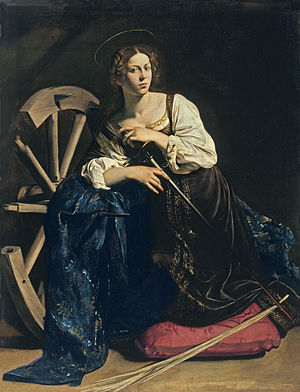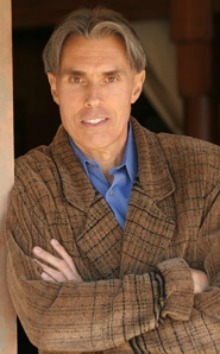Matt Rees's Blog - Posts Tagged "baroque"
Me and St. Catherine: Why I Wrote a Novel About Caravaggio
 On the upper floor of the Museo Thyssen-Bornemisza in central Madrid, I wandered into a broad room where the masterpieces were arrayed like chocolates in a box. Just as with an assortment of sweets, I knew immediately and innately which one attracted me. I stepped into the arms of Caravaggio’s Saint Catherine of Alexandria. She still hasn’t let go.
On the upper floor of the Museo Thyssen-Bornemisza in central Madrid, I wandered into a broad room where the masterpieces were arrayed like chocolates in a box. Just as with an assortment of sweets, I knew immediately and innately which one attracted me. I stepped into the arms of Caravaggio’s Saint Catherine of Alexandria. She still hasn’t let go.I was in Madrid on a book tour for the Spanish translation of the first of my Palestinian crime novels. The Thyssen is just across the wide, busy Paseo del Prado from the immense museum of that name. It’s a building with two wings: a traditional classical palace in burnt sienna and pink stone; alongside a block of bright white louvered walls and angled blue-glass rooflights, like an old auto factory transported to a sci-fi future. I had no idea what awaited me inside. No idea that my novel A NAME IN BLOOD, which is published in the UK in a few weeks, would grow out of it.
The Caravaggio works I had previously seen in London and New York had impressed me. I was aware of the conventional summary of the stylistic revolution he wrought: to fill his canvasses with darkness and, with a strategically placed lantern, to bring the central action shining out of the shadows. That technique has been a major influence on filmmakers like Scorsese and almost every professional photographer, which is why Caravaggio’s four-hundred-year-old paintings look so modern. I knew something about his life too, though largely through the weird distortions and art-house tedium of Derek Jarman, having seen the British director’s Caravaggio film in college. As a writer, however, I’ve found a confluence of impressionability and idea lies behind every novel, so that only at one given time can you write a particular novel. A few years previously, I might’ve seen Saint Catherine, considered her for a moment, then moved on, as I had done when I saw Caravaggio’s The Supper at Emmaus in London’s National Gallery. But, for some reason, when I entered her room at the Thyssen and she spoke to me, I was listening.
I stayed in that room a long time. I couldn’t say quite how long. But it was at least an hour. The other paintings held my attention a matter of moments. I can’t remember them. (I’ve had similar experiences when I’ve traveled to see Caravaggio’s art around the world since then. No artist has such a capacity to make everything else in a gallery ignorable as Caravaggio has). In the Thyssen, I recall that the walls were of a beige rough fabric, a little like delicate sackcloth. The ceiling was white. Details as scant as you might retain from love-making. You might forget your mood or the immediate surroundings, but you’d have a clear picture of the way she looked at you or the feel of her hand on the back of your neck. Of Catherine, I remember everything. Even things that weren’t on the canvas.
The eyes of Caravaggio’s saint were possessive, grasping and sensual, clandestine and forbidden. For much of the time I was with her, we were alone. It felt as intimate as the languor after an act of love. There’s a question in that post-coital moment and Catherine asked it of me: Is this the last time? Will I see you again? Do you want to know more about me and where I come from?
Eventually I tried to leave the empty room. In her face I saw a plea. As if she wanted me to know that by leaving I would abandon her to her fate, represented by the spiked wheel on which she leaned (where the saint was tortured, before she was dispatched with the sword whose shaft she fondles.) What’s so compelling (and in his day was controversial) about Caravaggio is that he didn’t expect the saint’s suffering to be enough to keep you on her side. He gave her the sexual magnetism of Fillide Melandroni, the whore he used as his model.
The hold Caravaggio subsequently took on me amounted to what many people would call an obsession. I prefer not to use that term, because it implies a degree of madness and the inability to see when you’re mistaken about something. A writer needs to know when he’s gone wrong. Still, I traveled all over Europe and America to see Caravaggio’s works. I learned to paint with oils, to fight with a rapier. I grew a beard like the one Caravaggio sported just before his death at age 39. I did a few others things that paralleled the artist’s life and which were too intimate, shameful, or mystical to be recounted here. So, go ahead, call it an obsession.
Published on June 05, 2012 02:23
•
Tags:
baroque, caravaggio, historical-crime, historical-novel, renaissance
Meeting Caravaggio at the Cafe: Mystical Research for my Novel
 In a Jerusalem café, I was drinking an espresso with Stephen Victor, an Oregon-based practitioner of a process called “family constellations.” I mentioned to him that I thought the process might be useful in my research for A Name in Blood, my historical novel about Caravaggio. Stephen agreed. Though the most common use of constellations is to resolve a family trauma that may even have occurred generations ago and been passed down to those living today, Stephen suggested that if I wanted to connect with Caravaggio about his life I should “just ask him––he’s out there.”
In a Jerusalem café, I was drinking an espresso with Stephen Victor, an Oregon-based practitioner of a process called “family constellations.” I mentioned to him that I thought the process might be useful in my research for A Name in Blood, my historical novel about Caravaggio. Stephen agreed. Though the most common use of constellations is to resolve a family trauma that may even have occurred generations ago and been passed down to those living today, Stephen suggested that if I wanted to connect with Caravaggio about his life I should “just ask him––he’s out there.”It was only a flash, but in that instant Caravaggio was sitting at Stephen’s right, opposite me. He wasn’t precisely “in a chair” next to Stephen. He was higher up, as if inset in a thought bubble. He was in the Jerusalem café, but he also appeared at the same time to be in a tavern in Rome four hundred years ago. He looked sad and yet comfortable in our presence.
Stephen knew Caravaggio was there too. He shivered violently and then shook it off with a twitch of his neck.
Subsequently I used constellations –– or more precisely I “just asked” Caravaggio and others in his life –– to feel my way deeper into the characterizations of A Name in Blood. Most particularly I found a response from Lena, the young woman who I believe was Caravaggio’s lover and who plays a central role in A Name in Blood.
As Stephen often says, this process is intellectually indefensible. So I don’t try to defend it. It happens to be what I’ve experienced, and when I’ve spoken to other creative artists, to actors and musicians, the most open ones often tell me they’ve had similar experiences or used similar techniques. Several German actors spent a night swapping constellations tales with me a year or so ago. My reading of some elliptical statements by Booker-award-winner Hilary Mantel suggests to me she may employ some similar process to achieve her astonishingly vivid characterizations.
The essence of the technique is to centre oneself in a meditative fashion. To focus one’s energy in one’s stomach, rather than in the head. The head is where we judge ourselves negatively––where we tell ourselves that this is all intellectually indefensible and we shouldn’t bother with it. In family constellations, when I’ve been open enough, I’ve felt the energy of someone else’s grandfather or someone’s fear or disease and allowed it to emerge as part of a healing process for that person. It’s the most remarkably cleansing feeling I’ve ever experienced.
Naturally I’ve heard from some people that this is nonsense. After I mentioned constellations while on a panel at a book fair, one of the other panelists, a very well-known British crime writer, joked: “I’m not channeling anyone. I’m doing all the typing.” A lady in the audience stood up to tell him that she thought his characterizations were very good and, therefore, she suspected he was employing something like the constellations technique without even knowing it.
Of course I’m doing the typing. I’m not channeling anyone or anything. Caravaggio didn’t write A Name in Blood, I did. If I was channeling him, I’d be painting, not writing, believe me.
But if you, like my British crime writer pal, think your head holds all the answers to everything, why does it choose to make life so miserable much of the time. Why does it fear an answer that might originate in some other part of the body?
In the West, there’s a tyranny of the brain, of the intellectually defensible. It’s like any of the other tyrannies we’ve embraced –– patriarchy, capitalism, monotheism. It demonizes any other way of thinking and often does so through mockery. If those systems don’t always work, they can be nipped and tucked, but don’t you even think of looking elsewhere for a better system. That’s the message at the heart of our culture of intellectual defensibility.
Personally I want my novel to be as good as it can be (and for me to be as happy as I can be). I don’t care what apparently silly things I have to do, what processes I must engage in, to get it that way. I know that A Name in Blood has been touched by Caravaggio, even if some might think that sounds daft.
Besides, the Caravaggio I met wasn’t at all the way you’d think from the writings of art historians. Their Caravaggio, as I’ve written elsewhere on this blog, was some kind of gay psycho bitch. But mine was different. I liked him. I hope you will too.
Published on June 14, 2012 02:57
•
Tags:
a-name-in-blood, art, art-history, baroque, caravaggio, crime-fiction, historical-crime, historical-fiction, renaissance, writing



